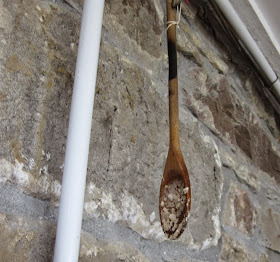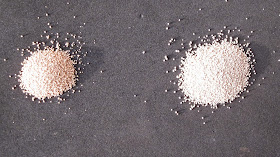"Our prehistoric fathers may have been savages, but they were clever and observant ones ... the art and practice of the brewer are founded on empirical observation ... the brewer learnt from long experience the conditions not the reasons for success"
John Tyndall FRS, extract from his speech on Fermentation, Glasgow Science Lectures Association, October 19th 1876.Before Louis Pasteur's investigation into fermentation the whole process was a complete mystery. It was considered to be part of the "Spontaneous Generation of Life", a supernatural, magical, mystical or even divine creation. This is why one mediaeval name for it was "Godisgoode", a demonstration of God's bounty and munificence.
John Tyndall continued Pasteur's work into fermentation and helped to demolish the myth of spontaneous generation by demonstrating that micro-organisms can be carried by air-borne dust, and cause all kinds of fermentations and cultures.
We now know that beer yeast is the microorganism, saccharomyces cerevisiae, a one celled fungus that feeds on simple sugars.
 |
| http://www.microbiologyonline.org.uk/about-microbiology/introducing-microbes/fungi |
In the presence of oxygen yeast can replicate rapidly through budding, turning the sugars into water and carbon dioxide, through respiration. It can double in 2 hours at 30 degrees Centigrade.
In the absence of oxygen it cannot replicate, but it can metabolise the sugars into alcohol and carbon dioxide. It isn't really happy with high alcohol concentrations and this limits production to about 10-12% alcohol.
Brewer's top fermenting yeast seems to work best, both aerobic and anaerobic, at between 15C to 25C, but it doesn't like varying temperatures and will lose condition quickly if subject to heating cycles. It generates quite a lot of heat whilst working.
I can sustain a good ferment of 10 gallons at ambient temperatures as low as 5C by insulating it with a couple of sleeping bags.
Under stress such as drying it can sporulate, and the spores can become wind-born by dust and insects.
Barm is the word used to describe brewing yeast in it's active replicating state.
The cells stick to the CO2 bubbles in the ferment and rise to the surface (top fermenting brewers yeasts) and form a foam. This is the Barm. Bread makers use this to leaven their doughs. Nowadays brewing yeasts and bread making yeasts differ, though in the past they were the same.
 | |
| Barm in the brewing buckets. |
 |
| Close view of Barm. |
This is how a beer brew looks after a day or two. It is at this point that the Barm can be harvested, by skimming the foam off and storing the liquid in a container. Harvested barm can remain viable for up to two weeks if it is kept cool and free from dust. Before the invention of refrigeration, a well could be used to store the barm in a warm climate.
Brewers are paranoid about infection by a wild yeast strain or other micro-organisms, so they prefer to start a brew by inoculating the warm wort with a proven viable yeast culture, the starter.
The starter is made by adding stored barm, or a dried yeast to a small amount of warm wort. Nowadays dried yeast can be bought, but there are traditional methods.
 | |
| A good starter for pitching on the wort. |
A Nordic and Hebridean tradition is to stir the barmy brew with a stick or wand, and to leave this to dry, hanging in a dry place. I've tried this and it works well. Could this be the origin of the magic witches wand?
 | |
| Harvesting Barm on a spoon. |
 | ||
| Drying spoon. |
 |
| Dried yeast - barm - on the spoon |
 | |
| Inoculation of wort |
 | ||||
| After 32 hours at 20C. |
 | |
| After 48 hours at 20C. |
 | |
| After 48 hours from the side. |
 | |
| After 96 hours. |
 | |
| After 96 hours. |
From the moment I first started grain beer brewing I used commercial packets of dried brewers yeast. I was often disappointed by the slow or even non-existent activation for the starter. Maybe I should have been more patient, like with the spoon, but then I would have to make the starter a day or two before the wort.
Eventually I found brewing supplier who packed their own yeast which set off vigorously in the starter, giving a viable pitch in half to one hour. I quite liked the fruity and sometimes even buttery flavours.
When we moved from Manchester to Orkney I had the same problem with packet yeasts, so I had the supplier post yeast up to me. One day when I was struggling to learn how to make bread with a machine, I realised that the yeast I had become so fond of looked indistinguishable from the bakers yeast.
I now use baker's bread making yeast.
 | |
| "Real Ale" brewer's yeast from a packet, left, and Baker's yeast from a tin, right. |
Many breweries are very particular about their own yeasts and indeed a lot of the flavour of the beer does indeed come from the yeasts action. Some traditional recipes actually call for bakers yeast to be used. There is a very interesting article on Sahti here, and in it there is a link to a comparison of brewers and bakers yeasts.
I am beginning to suspect that the distinction between brewer's and baker's yeast only came about with the industrialisation of brewing in the Georgian era. I am certain brewing came before the leavening of bread, if not even before the invention of bread itself.
I have much more to say about yeast, microbes and infections but this post is already getting long, so there will be a part 2 to follow.
interesting, I heard ale yeast prefers sugars and bread yeast prefers starch so there is a reason they're marketed differently
ReplyDelete